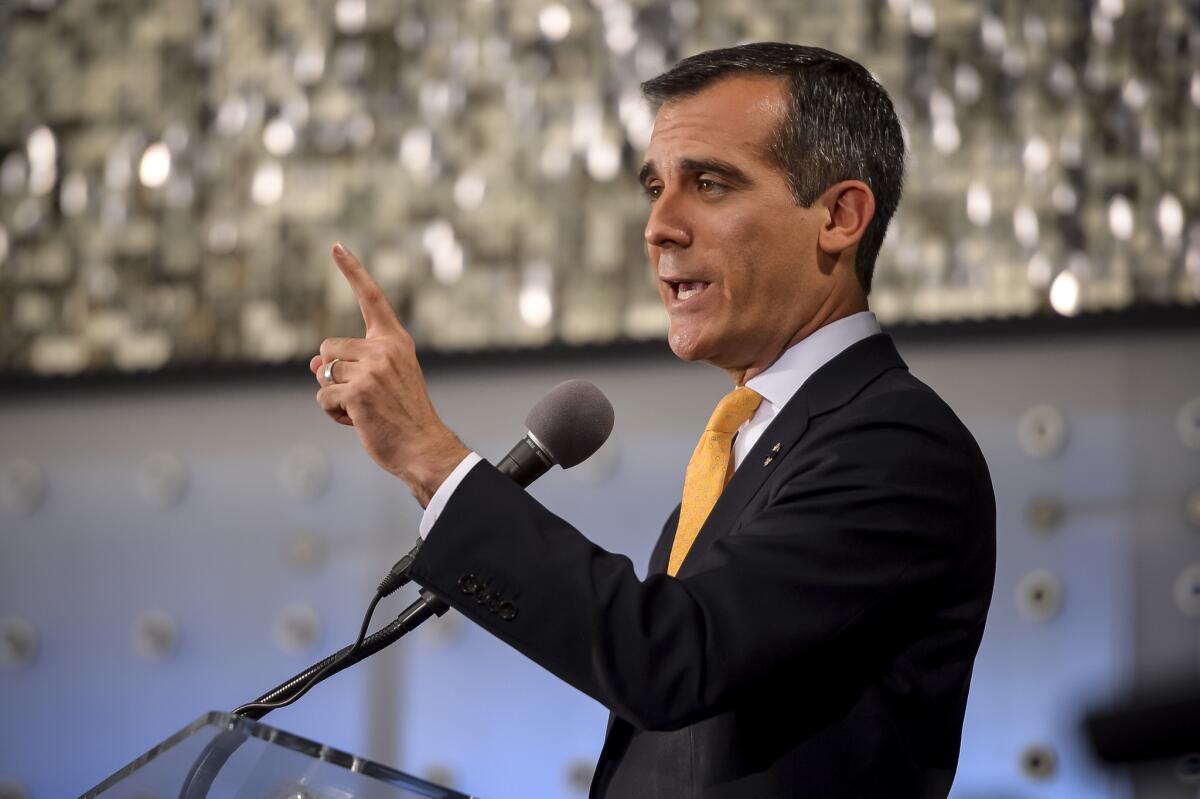Eric Garcetti, L.A.’s back-to-basics mayor

- Share via
It’s been nine months since I took a leave from this column to complete a book project, and a lot has changed in Los Angeles during that time: Eric Garcetti, who had just taken office when I left, has built an administration, submitted his first budget and established himself as mayor.
Mayors invariably are compared to their predecessors, and Garcetti at this early stage is both the heir of Antonio Villaraigosa and his welcome antithesis. Like Villaraigosa, he’s liberal and hardworking; unlike Villaraigosa, he’s patient, perhaps to a fault, and he’s determined to manage the city, not just to imagine its future.
Villaraigosa was a national figure from the moment of his election, and he reveled in the attention. Less than two months after he took office, Time magazine declared him one of the “25 titans leading the Latino charge into the 21st century” (which may say more about Time magazine than Villaraigosa). Villaraigosa responded with high ambition: He would take charge of the schools, plant a million trees, build grand projects.
Garcetti delivered his first State of the City address a couple of weeks ago, and the highlight was his ode to a city worker who figured out a better way to turn off the air conditioning at city recreation centers.
The worker’s ingenuity is saving the city money, for which he deserves praise. But highlighting him in such an important speech was emblematic of Garcetti’s determination to focus on the incremental rather than the monumental.
It’s easy to lampoon that. LA Weekly, never a big Garcetti fan, noted in February that “when it comes to advancing new policies, his record is surprisingly thin.” Maureen Dowd of the New York Times dropped in on Los Angeles in March and reported that “City Hall has its own version of ‘Where’s Waldo?’ called ‘Anyone Seen Eric?’”
But Garcetti’s low profile is not evidence that he’s loafing; it’s a deliberate strategy, and one that defies the accepted wisdom of how modern L.A. mayors make change, in response to crises or outside the formal powers of the office.
Richard Riordan’s great achievements were restoring the city after the riots and Northridge earthquake, equipping the Los Angeles Police Department and rewriting the city charter, none of which was really a function of his office.
James Hahn’s single term was highlighted by his defeat of San Fernando Valley secession — tribute to a savvy political campaign rather than a formal duty of the mayor.
Villaraigosa picked up Riordan’s commitments to education and public safety and pioneered a new vision in public transportation, mostly by working with President Obama and Congress.
Garcetti is challenging that model. He has promised to get “back to basics” and rediscover sound fundamentals such as efficiency and accountability. That avoids the pitfalls of Villaraigosa’s habit of over-promising and under-delivering, but the trouble with Garcetti’s approach is that the “basics” he’s focused on so far are notably less exciting than the big-ticket items of his predecessors.
None of which seems to worry the mayor much. As we talked in his office a few days ago, Garcetti was buoyant and, as usual, cheerful and smart. His wife, daughter and other family members flitted in and out, but he seemed undistracted, instead plowing through his list of accomplishments and proclaiming his “love, love, love” for his job. He rattled off a host of small-ball wins: luring a company to relocate to the city, persuading another to stay; convening mayors, business leaders and university presidents to talk about regional issues and economic growth; holding the line on water and power rates.
He’s the first to acknowledge that none of that is earth-shattering, but as he sees it, the mayor exercises power in three ways: the informal authority that comes with the office, the governance power to advance new policies and programs, and management of the city itself. “The third,” he said, “has been missing.” And that’s where he is focusing first.
When I asked him what kinds of standards he’ll use to judge success, he was clearly ready for the question, jumping up — he moves fast — from his armchair and snatching a white binder from next to his desk. It’s full of quantifiable benchmarks for an array of city services: J.D. Power and Associates is surveying DWP customers about their satisfaction with their water and power service; Animal Services is being judged by the number of spays and neuters it performs; the Fire Department is being measured by response times and the LAPD on levels of crime; and the Bureau of Contract Administration will be held accountable for the turnaround time on bonds. Garcetti is methodically examining other departments too, and building metrics to judge them.
That’s important work, and he deserves credit for taking it on. It is, as Garcetti likes to say, laying a foundation, a job too often neglected by his predecessors. But what comes next is what will define Garcetti and the city he leads. Once you lay the foundation, you need to build something impressive on top of it, or it’s just a concrete slab.
Twitter: @newton_jim
More to Read
A cure for the common opinion
Get thought-provoking perspectives with our weekly newsletter.
You may occasionally receive promotional content from the Los Angeles Times.











